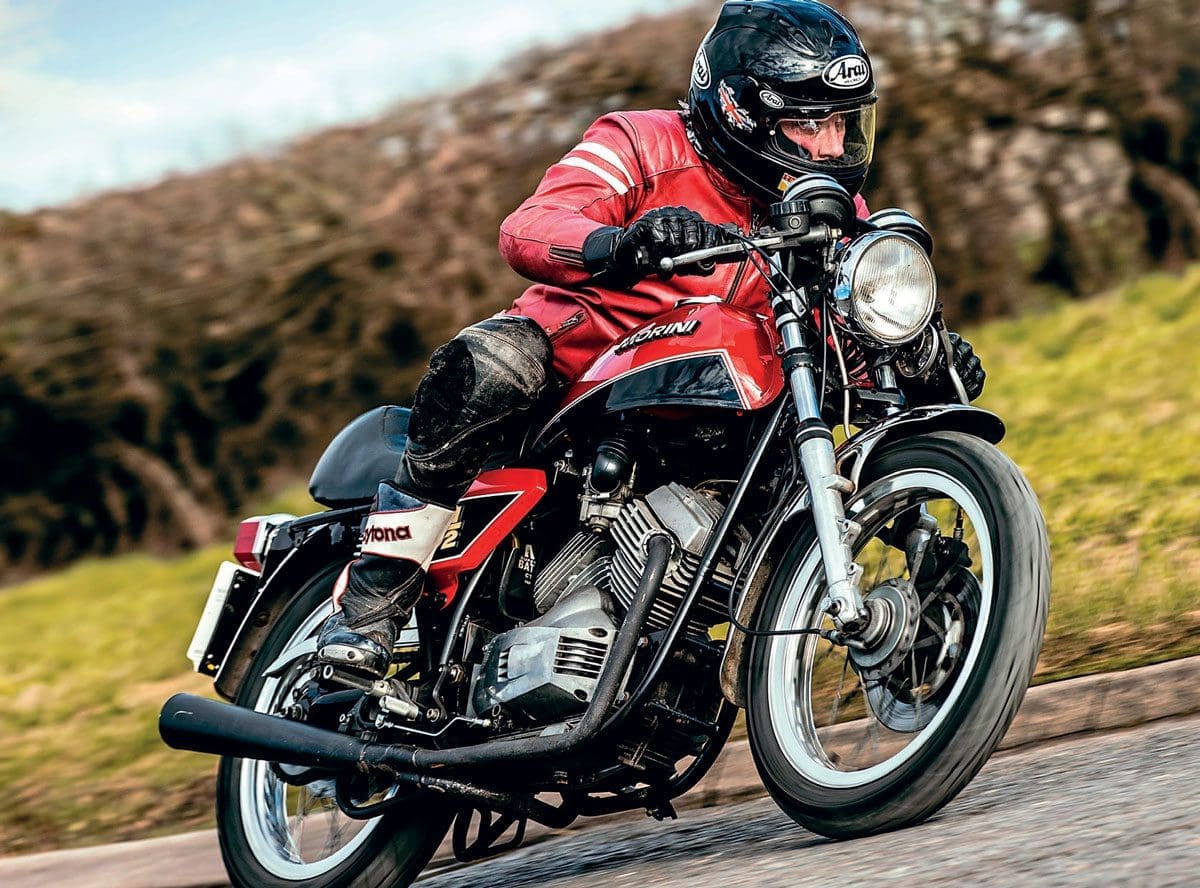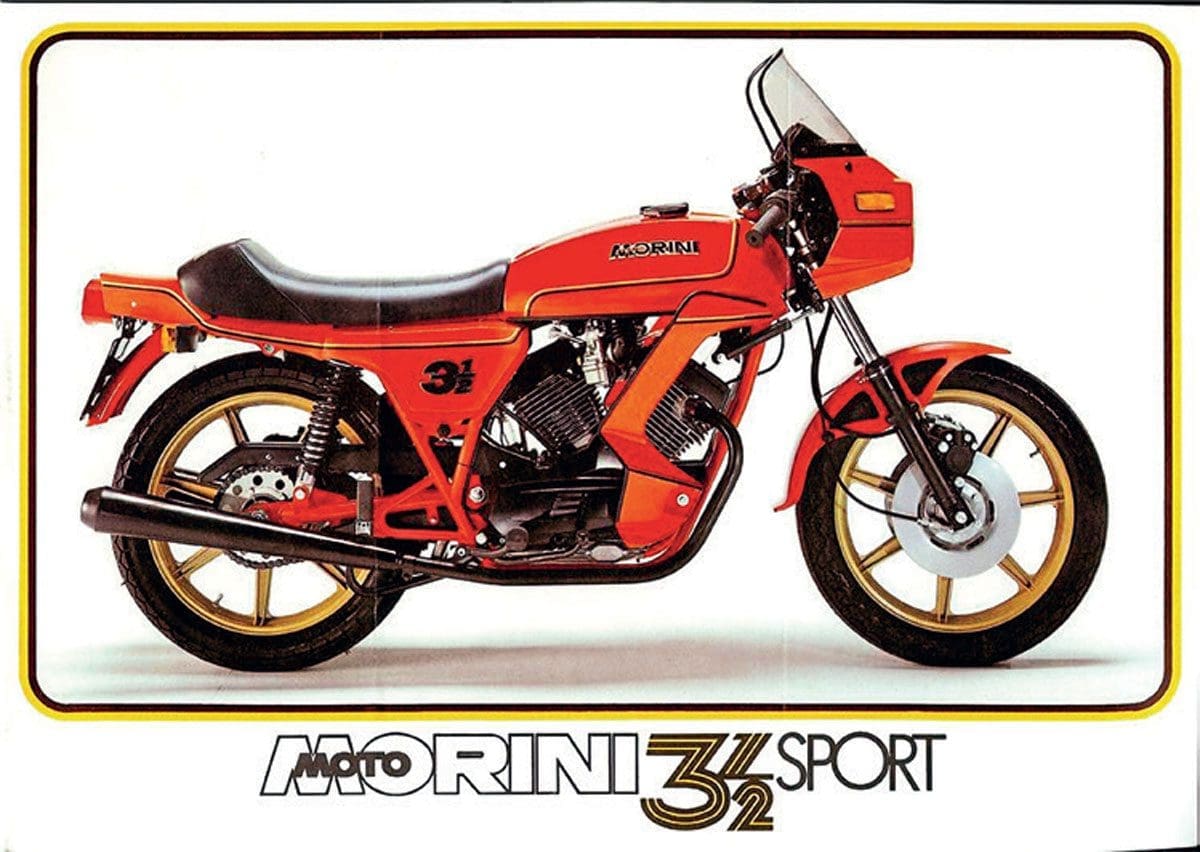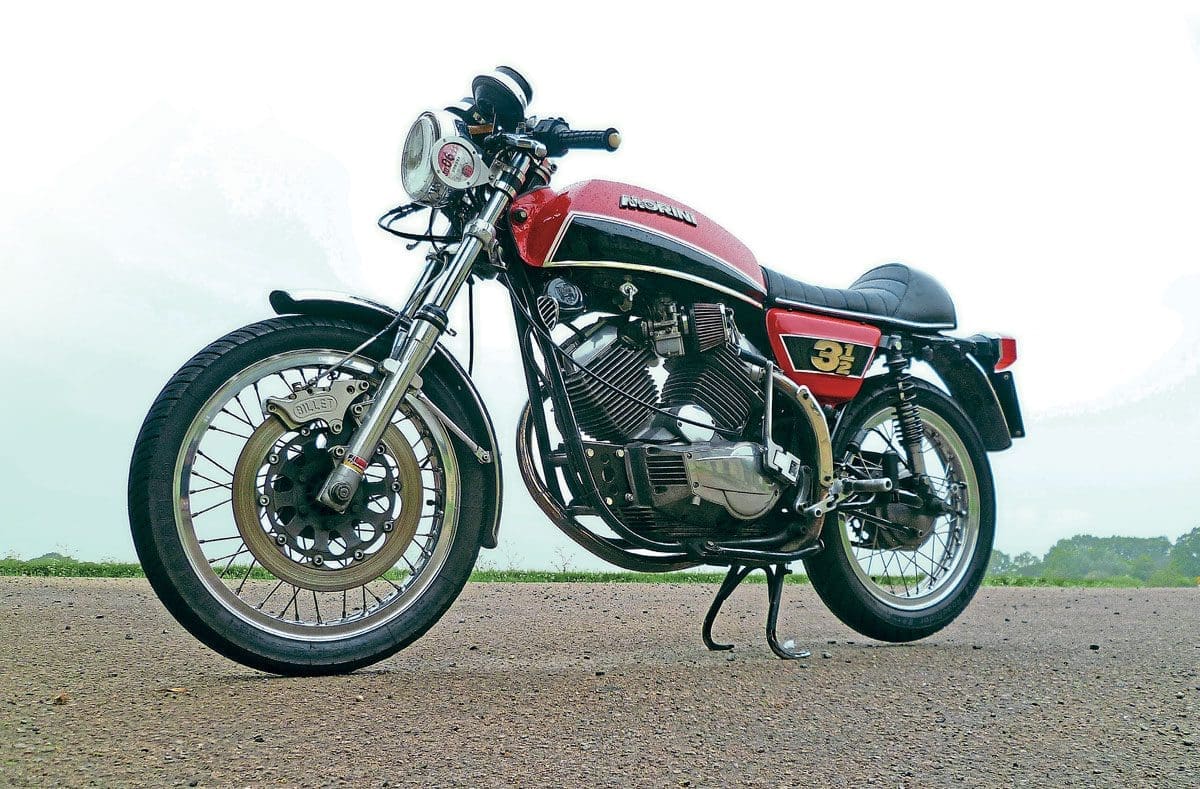
Italian sports bikes of the 1970s seem to be defined by big brawny bruisers like the three-cylinder Laverda Jota and L-twin Ducati 900SS.
But there were also smaller capacity machines built by Italian manufacturers that not only had a sporting heritage but also became intensely desirable machines with a cult following.
Like many Italian motorcycle manufacturers, pre-1971 Morini was primarily known for its small capacity single-cylinder, sports-focussed motorcycles, while Ducati, Laverda and Motor Guzzi then moved to large capacity vee twins in their pursuit of the ultimate road-burning motorcycle.
So Morini chose to effectively double up on their small capacity machinery and built a twin cylinder 350, albeit also of vee twin architecture.
The Morini motorcycle company was started by Alfonso Morini, the co-founder and racer for Italian manufacturer MM who left his former company just before the start of the Second World War. His first bikes were 123cc two-strokes, which entered production in 1947.
They were soon supplemented by four-stroke versions, including various 173cc overhead cam models, although development continued on the smaller machines, with the 1954 overhead cam 123cc bike making an impressive 16bhp and having a genuine 100mph top speed!
The Bologna company began to change focus when the company’s founding father passed away in June 1969, with his daughter, Gabriella, taking over control and remaining in place until 1986, after which the company fell under the control of the Cagiva group.
While the Ferrari-trained engineer Franco Lambertini designed a 125cc single in 1971 after he moved from Modena to work at Morini, it had some features that were used when he designed a vee twin immediately after, and which was first displayed at the ’71 Milan Show.
The 125cc single-cylinder Morini Corsaro Regolarita was designed by Lambertini using a Heron-style cylinder head. Heron heads incorporate vertical, parallel valves with a flat head shape, the combustion chamber design being cast into the top of the piston. The principal had already seen use in cars – and in Formula One racing, too – but this was a first for motorcycles and is said to be a particularly efficient design.
With a combined capacity of 344cc from the two cylinders – uniquely used in a strange derivative of metric measurements to create the name 3 ½ – the vee twins were of a 72° vee design, with the rear cylinder offset by 5cm to alleviate any overheating problems.
Not only did this work, but it is said that the angle of the rider’s legs actually divert cooling air over the rear cylinder so it can actually run cooler than the front pot!
Unusually for the time, the overhead valve engine not only used a toothed belt to drive the cams but also had electronic ignition, a dry multi-plate clutch and a six-speed gearbox, while the compact design of the engine allowed for a short chassis (just 1371mm, 53.98in wheelbase) to aid handling.
Two years after the prototype was shown in Milan, the production Strada (also known as the GT) version was launched, with the Sport version coming out the following year.
Somewhat unsurprisingly, the little Morini entered the market with Marzocchi suspension front and rear, while the 230mm (9in) double-sided leading shoe front brake was seen by some as being a little over-the-top for such a small machine and more than a match for the 35bhp that the engine provides, although the reality was that it faded quickly and was often grabby – a dubious combination at the best of times. The single 260mm (10in) Grimeca disc that arrived in ’77 was welcomed, and there was also a factory upgrade to twin discs available at the same time.
The end result was a delicate little jewel of a bike that seemed rarer than big Ducatis or Guzzis, yet had just as much potential as a sporting steed for the rider who liked to get involved with the business of getting the best out of a bike.

But that giant-killing reputation came at a price – and not just the rumours of reliability issues brought by Italian electrics and a spate of broken connecting rods in very early models, which was solved with a change of supplier.
The electrical issues were partly borne by a lack of trust in the totally electronic ignition (made by Ducati Electrotechnica) that actually worked rather well, and gave a large range of advance to give easy kickstarting (with the left-hand kickstarter) with no kicking back. There was also the electromagnetic fuel tap which opened up when the ignition was turned on that was seen as being a bit of black magic to those used to physically turning the fuel on by hand.
The fact that hot starting also needed full choke for the twin Dell’Orto carbs could have also caused confusion and a poor reputation for reliability. The one thing that was most definitely an issue was the poor quality switchgear, giving rise to a number of problems that weren’t just limited to the fact that the paint fell off so you’d have to memorise which way the switches went for lights on/off etc.
The Strada was soon looked upon as the weaker option once the Sport came onto the market, although neither were seen as being cheap, utilitarian bikes thanks to the price, often quoted as being the same as a Honda CB750, though fuel consumption figures that bettered 70mpg went a small way to balancing out the finances.
The Sport was actually a more comfortable bike to ride for many, regardless of the clip-on handlebars and rearset footpegs, the reason being that the Strada had footpegs that were uncomfortably situated and gave a peculiar riding position, only suitable for those with the ergonomics of an ape (so some owners have told us).
So, with more comfort, better looks and more power courtesy of an increased compression ratio and a new camshaft, the Sport was clearly the model to go for. To be fair, the additional 4bhp that the Sport makes is hardly worth the extra dosh, although the improved comfort is – especially when you bear in mind that the three-and-a-half gallon fuel tank could perhaps carry you more than 200 miles between fuel stops!
Unsurprisingly, there have been many folk who have made handlebar and footpeg changes to make their Strada look like a Sport but without the internal modifications, although the sweet handling is just as good with the Strada… so it all becomes personal choice.
Legend has it that women were employed to work in the Morini factory for the simple reason that they were cheaper to employ, and because it’s a simple engine to work on, small, delicate hands would be perfect for small engine components.

Of course, women are more than capable of working on big, hefty and complicated engineering – but in the tight financial situation that northern Italy found itself in the 1970s, every option to reduce overheads had to be made.
While the initial 344cc capacity coincided rather neatly with a taxation bracket that saw a big jump in costs for bikes of over that capacity, Morini still decided to show a larger version in 1975 in Milan, with the 500cc Strada appearing that used the exact same crankcases but with larger barrels and a longer stoke crank.
These reached the market in 1978, at the same time that wire wheels were replaced with cast versions. The larger bike, actually 479cc, initially had only a five-speed gearbox, with the thinking that the torquier engine didn’t need as much cog-swapping, although it was later upgraded to a six-speed transmission in 1982.
Thanks to the relatively high cost of the little vee twins – the 31/2 was £347 more than a Yamaha two-stroke twin that cost £530, ownership was for those who wanted something a little different to the norm, which admittedly is something that could be said of anyone who owns any Italian bike from the 1970s. But the Morinis have always had a cult following, even in the early days, a time when Benjy Straw ran his specialist shop in South London, Wee Vee.
Sadly, Benji’s shop is long gone (although he’s still around, specialising in auto electrics nowadays), with North Leicester Motorcycles taking over the mantle of Morini classic specialist for some time before retiring. All the stock was bought by fine people of Mdina Italia in West Yorkshire.
Morini continued with a relatively slow development of both the 350 and 500 twins, with Nikasil bores and a left foot gearchange appearing on the 350 in 1983, trail/Dakar-style versions appearing (the Kanguro, Coguaro and Camel), and even a couple of factory customs (the Excalibur and New York) alongside faired versions of the original.
After Cagiva took over, the 350cc engine was fitted into a Cagiva Freccia 125 chassis to create the fully-faired, modernistic and very unique Dart.
In 1999 Morini passed from the Cagiva group into the hands of Texas Pacific Group, that also bought Ducati, but the rights to the name were then sold to a company formed by Alfonso Morini’s nephew in 1954, Morini Franco Motori spa.
After building several large capacity water-cooled vee twins in the early 21st century, the company hit financial issues, stumbling through to 2018 via various model launches, and then being bought by the Zhongneng vehicle group.
It looks as though this classic brand will be another that will be revitalised by those in the Far East, who have a product but need a western brand name to hang it off. But the Morini 31/2 will forever be in the Posh Totty hall of fame for its giant-slaying, its beauty, its charisma – and its ability to do this with less weight and less size than most others.



